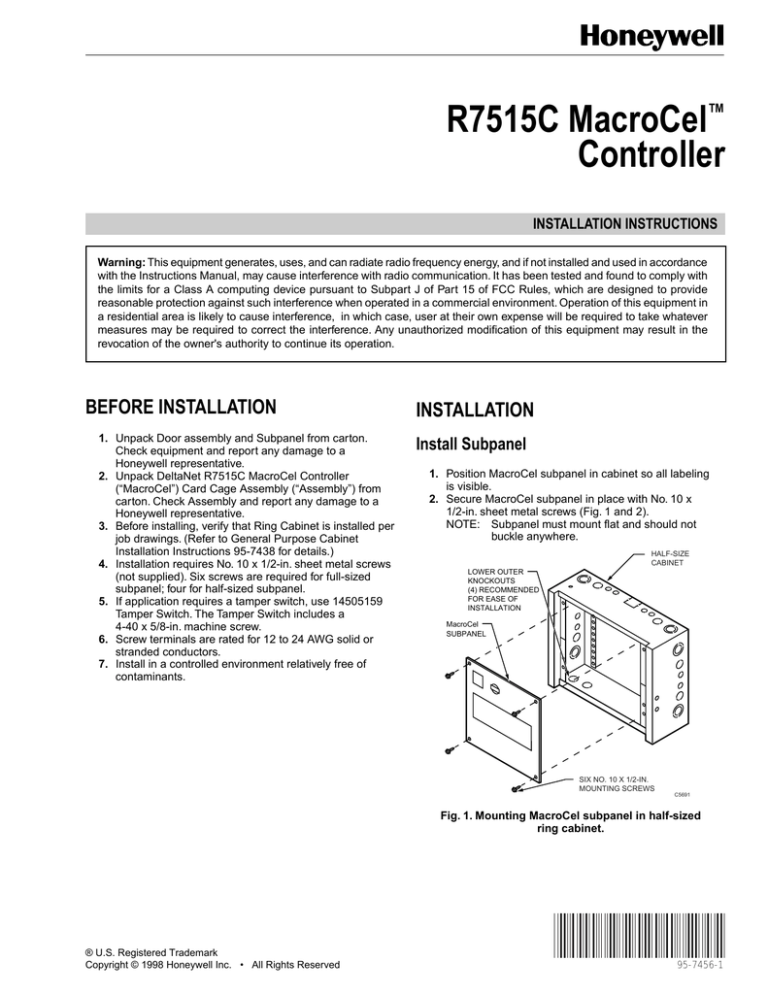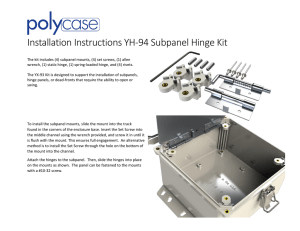
R7515C MacroCel™
Controller
INSTALLATION INSTRUCTIONS
Warning: This equipment generates, uses, and can radiate radio frequency energy, and if not installed and used in accordance
with the Instructions Manual, may cause interference with radio communication. It has been tested and found to comply with
the limits for a Class A computing device pursuant to Subpart J of Part 15 of FCC Rules, which are designed to provide
reasonable protection against such interference when operated in a commercial environment. Operation of this equipment in
a residential area is likely to cause interference, in which case, user at their own expense will be required to take whatever
measures may be required to correct the interference. Any unauthorized modification of this equipment may result in the
revocation of the owner's authority to continue its operation.
BEFORE INSTALLATION
1. Unpack Door assembly and Subpanel from carton.
Check equipment and report any damage to a
Honeywell representative.
2. Unpack DeltaNet R7515C MacroCel Controller
(“MacroCel”) Card Cage Assembly (“Assembly”) from
carton. Check Assembly and report any damage to a
Honeywell representative.
3. Before installing, verify that Ring Cabinet is installed per
job drawings. (Refer to General Purpose Cabinet
Installation Instructions 95-7438 for details.)
4. Installation requires No. 10 x 1/2-in. sheet metal screws
(not supplied). Six screws are required for full-sized
subpanel; four for half-sized subpanel.
5. If application requires a tamper switch, use 14505159
Tamper Switch. The Tamper Switch includes a
4-40 x 5/8-in. machine screw.
6. Screw terminals are rated for 12 to 24 AWG solid or
stranded conductors.
7. Install in a controlled environment relatively free of
contaminants.
INSTALLATION
Install Subpanel
1. Position MacroCel subpanel in cabinet so all labeling
is visible.
2. Secure MacroCel subpanel in place with No. 10 x
1/2-in. sheet metal screws (Fig. 1 and 2).
NOTE: Subpanel must mount flat and should not
buckle anywhere.
HALF-SIZE
CABINET
LOWER OUTER
KNOCKOUTS
(4) RECOMMENDED
FOR EASE OF
INSTALLATION
MacroCel
SUBPANEL
SIX NO. 10 X 1/2-IN.
MOUNTING SCREWS
C5691
Fig. 1. Mounting MacroCel subpanel in half-sized
ring cabinet.
® U.S. Registered Trademark
Copyright © 1998 Honeywell Inc. • All Rights Reserved
95-7456-1
R7515C MacroCel™ CONTROLLER
SIX NO. 10 X 1/2-INCH
MOUNTING SCREWS
Wire Subpanel to Interface Board
FULL-SIZE
CABINET
NOTES:
1. All wiring must conform to local codes,
ordinances, and regulations. Refer to job
drawings for details.
2. Use copper conductors only.
3. For 220/240V ac 50/60 Hz installations, verify
that voltage difference between any conductor
and earth ground does not exceed 150V ac.
4. An End-of-Line Resistor (EOLR) for use with the
C-NAP bus wiring is integral to the MacroCel
Subpanel Interface Board.
MacroCel
SUBPANEL
CAUTION
Verify that ac power is not connected to MacroCel
power wiring terminal block (H-N-G) until system is
checked by a Honeywell Representative.
Wire the Subpanel as follows:
1. Connect field wiring to MacroCel subpanel Interface
Board or accessory devices per job drawings. Figure 3
shows MacroCel interface board terminal arrangement.
Figure 4 shows typical wiring.
LOWER OUTER KNOCKOUTS (4)
RECOMMENDED FOR EASE
OF INSTALLATION
C5690
Fig. 2. Mounting MacroCel subpanel in full-sized
ring cabinet.
TB3
TB4
R5 29
R7 43
D1 3
RTD
DIG
DIG
4
+10 5
VOLT
RTD
2
TERM V1
V1 6
R1
R2 8
RTD
9
D2 10
DIG
11
+10 12
VOLT
TERM V2
V2 13
R2
14
D3 17
DIG
18
+10 19
VOLT
7
RTD
16
R3
21
R4 22
23
DIG
25
+10 26
VOLT
VOLT
RTD
D4 24
R4
28
DIG
32
TERM V5
V5 34
R5
35
R6 36
37
D6 38
VOLT
VOLT
DIG
39
TERM V6
V6 41
R6
42
TB10
44
46
TO-3 64
COM3-4 65
TO-4 66
TERM V7
V7 48
R8 50
T1 67
T2 68
51
T1 69
D8 52
T2 70
T1 71
T2 72
49
R7
53
+10
VOLT
54
TERM V8
V8 55
J2
7
3
O
U
T
P
U
T
CR2
MacroCel
INTERFACE
BOARD
F1
2A
7
5
7
6
TB9
TB6
ANALOG
JB1
1
2 1&2 IN
3 2&3 OUT
EOL
2
4
V
A
C
TB7
AO—1 77
RET 78
AO—2
RET
AO—5
RET
A
AO—3 89
RET 90
79
80
81
ANALOG
82
A 83
K1
CNAP
BUS
ON
JACK
TB8
POWER
J4
7
4
0.16A MAX
C1
POWER
LED
J3
T
R
I
A
C
+
R8
56
CNAP
OUT
IN
+
+
TB5
TO-1 61
COM1-2 62
TO-2 63
INPUTS
J1
24 VDC
+
5 5 5 6
7 8 9 0
0. 16A MAX
D7 45
+10 47
RTD
+10 40
TERM V4
V4 27
D5 31
+10 33
TERM V3
V3 20
RTD
30
+
24VAC T1
DIG
TB2
R3 15
24VAC T2
RTD
TB1
R1 1
J8
C 84
B 85
K3
AO—4 91
RET 92
AO—4
RET
A
C
B
A 86
K2
CNAP
BUS
C 87
B 88
K4
93
94
95
96
97
A 98
C 99
B 100
OUTPUTS
S1
J5
OFF
J6
J7
MOUNTING
TAB (2)
MacroCel
CARD CAGE
WALL MOD
CONNECTOR J8
SUBPANEL
SUPPORT (2)
C5611
Fig. 3. MacroCel interface board terminal arrangement.
95-7456—1
2
MOUNTING
TAB (2)
MacroCel
INTERFACE
BOARD
4
D1 3
11
D2 10
9
R2 8
7
V1 6
VOLT
14
V2 13
+10 12
DIG
RTD
VOLT
J1
R2
18
25
D4 24
23
R4 22
21
V3 20
VOLT
28
V4 27
+10 26
DIG
RTD
VOLT
+10 19
DIG
16
D3 17
MacroCel
CARD CAGE
TERM V2
R1
TERM V1
RTD
R3 15
2
R1 1
+10 5
DIG
RTD
J2
32
D5 31
30
R5 29
39
D6 38
37
R6 36
35
V5 34
VOLT
42
V6 41
+10 40
DIG
RTD
VOLT
+10 33
DIG
INPUTS
R4
TERM V4
R3
TERM V3
RTD
TB3
J3
R6
TERM V6
R5
TERM V5
46
D7 45
44
R7 43
53
D8 52
51
R8 50
49
V7 48
56
J4
R8
TERM V8
R7
24 VDC
+
3
C1
F1
2A
+
T2 70
T1 71
T2 72
T1 69
T2 68
T1 67
TO-4 66
TO-3 64
COM3-4 65
TO-2 63
TO-1 61
COM1-2 62
TB5
Fig. 4. MacroCel typical wiring.
CR2
POWER
LED
5 5 5 6
7 8 9 0
0. 16A MAX
TERM V7
TB10
+
WALL MOD
CONNECTOR J8
VOLT
V8 55
+10 54
DIG
RTD
VOLT
+10 47
DIG
RTD
TB4
O
U
T
P
U
T
TB8
POWER
2
4
V
A
C
T
R
I
A
C
24VAC T1
TB2
24VAC T2
TB1
J8
7
5
7
6
J5
OFF
CNAP
BUS
ON
JACK
K1
ANALOG
TB9
S1
K2
CNAP
BUS
JB1
1
2 1&2 IN
2&3
OUT
3
EOL
A
7
4
0.16A MAX
7
3
CNAP
OUT
IN
+
+
K4
K3
J6
SUBPANEL
SUPPORT (2)
OUTPUTS
A 86
C 87
B 88
C 84
B 85
A 83
RET 82
RET 92
J7
A 98
C 99
B 100
C 96
B 97
RET 94
A 95
AO—4 93
AO—4 91
RET 80
AO—5 81
ANALOG
AO—2 79
TB7
AO—3 89
RET 90
TB6
AO—1 77
RET 78
C5611
R7515C MacroCel™ CONTROLLER
95-7456—1
R7515C MacroCel™ CONTROLLER
2. Connect C-NAP bus wiring to C-NAP terminal block on
MacroCel per job drawings (Fig. 5).
TB9
YEL
YEL
RED
7 7 7
4 5 6
0.16 MAX
RED
7
3
C-NAP
TERMINAL
BLOCK
+
+
NOTES:
1. Lower edge of Assembly is supported by two supports
on the Subpanel (Fig. 8). Do not force Assembly into
supports. If supports interfere with mounting Assembly,
gain proper clearance by using pliers to bend supports
outward slightly.
2. Two mounting tab screws are factory installed (started)
to aid in mounting the Assembly.
MacroCel
INTERFACE
BOARD
CNAP
OUT
IN
+
+
Mount MacroCel Card Cage Assembly
C5693
Fig. 5. Connecting C-NAP bus wiring to C-NAP terminal
block on MacroCel.
PREINSTALLED
MOUNTING TAB
SCREW (2)
3. When required, activate the EOLR on the MacroCel
Subpanel Interface Board by placing the shorting bar in
Position 1-2 (Fig. 6A). Deactivate the EOLR by placing
the shorting bar in Position 2-3 (Fig. 6B).
MacroCel
SUBPANEL
INTEGRAL
SUPPORT
C5689
A
Fig. 8. Subpanel supports and preinstalled mounting
tab screws.
A
1
SHORTING BAR
1
1 & 2 IN
2
3
SHORTING BAR
2 & 3 OUT
2
3
EOL
A. EOLR "IN"
1 & 2 IN
2 & 3 OUT
EOL
B. EOLR "OUT"
C5687
Fig. 6. MacroCel subpanel interface board EOLR
positions for activation (IN) and deactivation (OUT).
4. Connect line voltage to AC Input Block. Leave power to
MacroCel subpanel OFF until system is checked by a
Honeywell Representative.
5. Mount optional Tamper Switch on cabinet and wire per
job drawings (Fig. 7).
Mount the Assembly as follows:
1. Position mounting surface of Assembly flat against
Subpanel, aligning sides of Assembly with sides of
mounting silhouette and top of Assembly approximately
1 in. (25 mm) above top of mounting silhouette.
2. Slide Assembly down, simultaneously engaging lower
supports and preinstalled mounting tab screws.
3. Tighten screws to secure Assembly to Subpanel.
4. Connect input/output board ribbon cables and power
cable to Interface Board in sequential order as they
protrude from the Assembly. Connect farthest-left
ribbon cable connector to J1 on the Interface Board,
farthest right ribbon cable connector to J7 (Fig. 3).
PLUNGER
LOCKNUT
PLUNGER
SCREW
RING
LOCK
WASHERS
FROM
TAMPER
SWITCH
SCREWS
FROM
DOOR
LATCH
TAMPER
SWITCH
AFTER INSTALLATION
1. Mount cabinet Door.
2. If applicable, adjust Tamper Switch screw (at end of
door switch plunger) so Tamper Switch activates when
door opens.
3. Close and lock Door.
DOOR
LATCH
Fig. 7. Mounting optional tamper switch.
C6039
By using this Honeywell literature, you agree that Honeywell will have no liability for any damages arising out of your
use or modification to, the literature. You will defend and indemnify Honeywell, its affiliates and subsidiaries, from and
against any liability, cost, or damages, including attorneys’ fees, arising out of, or resulting from, any modification to the
literature by you.
Home and Building Control
Honeywell Inc.
Honeywell Plaza
P.O. Box 524
Minneapolis MN 55408-0524
95-7456—1 T.M. 2-98
Home and Building Control
Honeywell Limited-Honeywell Limitée
155 Gordon Baker Road
North York, Ontario
M2H 3N7
Printed in U.S.A. on recycled paper containing at least 10%
post-consumer paper fibers.
www.honeywell.com



